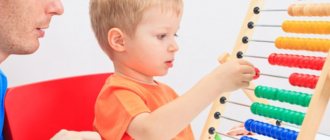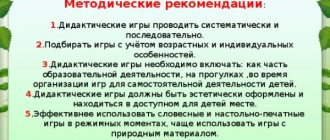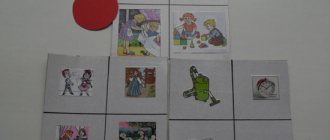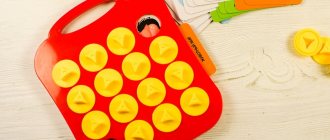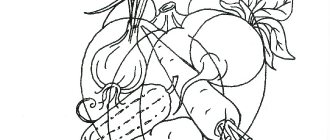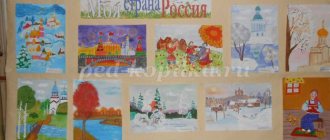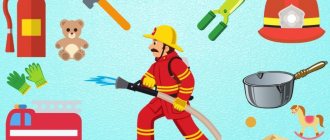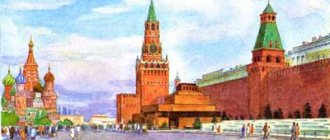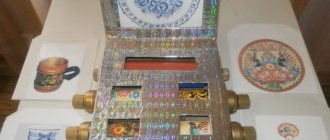Didactic games for sensory and mathematical development of children 5-7 years old
Didactic games for sensory and mathematical development of children of senior preschool age.
Didactic manual for sensory and mathematical development of preschool children. A didactic game is a complex phenomenon, however, it clearly expresses the components - the main elements that define the game as a form of learning and gaming activity at the same time. Mathematics is a constantly evolving science. The activity develops techniques of mental operations and qualities of the mind, but not only that. Mathematics contributes to the formation of memory, speech, imagination, feelings; develops endurance, patience, and creative personal development occurs. And it is necessary to remember that mathematics is the only one of the more complex academic subjects. A modern kindergarten is a place where a child gains experience of broad emotional and practical interaction with adults and peers in the most significant areas of life for his development. The developmental environment of an educational institution is the source of the development of the child’s subjective experience. Each of its components contributes to the child’s development of experience in mastering the means and methods of cognition and interaction with the outside world, and the experience of the emergence of motives for new types of activities. The enriched development of a child’s personality is characterized by the manifestation of direct childish inquisitiveness, curiosity, and individual capabilities; the child’s ability to cognize what he saw, heard (the material and social world)
and respond emotionally to various phenomena and events in life; the desire of the individual to creatively display the accumulated experience of perception and cognition in games, communication, drawings, and crafts.
A preschooler aged 5 to 7 years must be able to:
1. A preschooler must solve simple puzzles and problems. 2. A preschooler must be able to subtract and add to numbers. 3. A preschooler must be able to determine the direction: forward, backward, right, left, up, down. 4. A preschooler should be able to count objects within 10 based on operations with sets. 5. A preschooler should be able to compare numbers: equalities - inequalities, more - less. 6. The preschooler must understand and answer questions correctly. How many? Which? Which one? 7. A preschooler must know the composition of the first ten numbers.
Today, and even more so tomorrow, mathematics will be needed by a huge number of people in various professions. Mathematics contains enormous opportunities for developing children's thinking in the process of their learning from a very early age. Visibility, consciousness and activity, accessibility and measure, scientific character, taking into account the age and individual characteristics of children, systematicity and consistency, the strength of knowledge acquisition, the connection of theory with the practice of learning and life, education in the learning process, a variable approach - this is the content completeness that is relevant for the child. The center for quiet games contributes to the development of cognitive processes (thinking, attention, memory, coordination of visual and tactile analyzers, fine motor skills, as well as perception and imagination, which, in turn, contributes to the development of the cognitive sphere of children. Children should master these skills at the age of 4- 7 years old. How quickly this will happen depends not only on the teacher and preschool children, but also on their parents, the children’s desire to learn. By teaching children using specialized literature, the teacher will very soon notice the first successes. But how to properly teach a child of 4 and 6 years old mathematics, in order to prevent mistakes and not instill an aversion to exact sciences.Material :
1. Balls made of fur, thread, prickly, rubber, plastic. 2. Strips of fabric: silk, nylon, wool, viscose, staple, etc. 3. Sheets with drawings of various animals and the number series from 1 to 10. 4. Cards with the number series from 1 to 10. 5. Sets of counting sticks, strings (laces) 6. Checked notebook sheets, simple and colored pencils.
Educational games and exercises:
1. “Find and show hard and soft surfaces.” Learn to feel hard and soft surfaces by touch; develop attention. The child feels all the surfaces of objects on the table and says which ones are hard and which ones are smooth. 2. “Find and show smooth, prickly and rough objects.” Learn to find objects with different surfaces by touch. The child feels objects and names which ones are smooth, which ones are prickly, which ones are rough. 3. “Describe the object.” Learn to convey your tactile sensations in verbal form; develop attention and thinking. A child, blindfolded, feels the toy on the panel and describes how it feels and its shape. 4. “Guess the object.” Learn to convey your tactile sensations in verbal form, develop attention and thinking. One child describes objects, the other guesses what he described. 5. “What number is missing?” Place cards with numbers from 0 to 10 drawn on paper in a row, then ask the child to close his eyes and at that moment remove one of the cards, moving the adjacent numbers to again form a continuous row. Having opened his eyes, the child must say which number is missing and where it should be. 6. “How many names do you know?” The teacher invites the children to say their full name one by one, taking a step forward with each name they name. The first calls male names, the second - female, the third again male, the fourth - female, etc. It is important that the children do not repeat themselves. Whoever advances the furthest wins. 7. “Compare the numbers” After showing the child two cards, we invite you to compare them. To begin with, the child names the meanings of the numbers, then answers the question which one is greater and by how many units. Then you should replace one of the cards and repeat the same questions. This activity can continue for quite a long time until the child loses interest in it. 8. “Draw a square” Develop ideas about geometric shapes and the ability to sketch them on a sheet of checkered paper. The teacher asks the children a riddle: We have four corners, four sides. All sides are equal and all angles are equal. (square)
The teacher invites the children to draw squares of different colors and shows the drawing sequence: “From the point to the right you need to draw a straight line equal to two cells, down draw another straight line equal to two cells, then to the left another similar line and up to the original points.
From the upper right corner of the square to the right, you need to count three cells and draw another identical square.” Children in their notebooks from the previous task count four cells down, put a dot and draw squares with a simple pencil to the end of the line. Then the teacher shows on the board the technique of shading a square from top to bottom, without lifting his hand. Children shade the squares with different colors. 9. “Count the objects” Since, in addition to numbers, there are various images on the cards, it is worth inviting the child to count them. You can also complicate the task by preparing sheets with drawings of various animals and a number series from 1 to 10. Having counted the number of animals, the preschooler must circle the corresponding number. As a rule, children really like this exercise and do not cause them any particular difficulties. 10. “What day of the week” Develops memory by remembering the names and sequence of days of the week. The teacher reads quatrains to the children, supporting them with finger exercises. Many different days of the week The birds sang to us about them On Monday the nightingale sang that there are no more beautiful days And on Tuesday the bird sang - the Yellow-sided tit The raven croaked that Wednesday was always the best day The sparrow began to tweet That on Thursday he flew into the forest Two doves cooed Sunday was discussed Birds know the days of the week They help us remember 11. “Making geometric shapes” The teacher reads poetry, and the children make geometric shapes from strings and counting sticks. Once upon a time there were two brothers: a triangle with a square.
The eldest is square, good-natured, pleasant. The youngest is triangular, always dissatisfied. He shouts to him: “Look, you are fuller and wider than me, I have only three corners, but you have four.” Children use counting sticks to model squares and triangles, then name the shapes.
But night has come, and to his brother, Bumping into corners, The younger one stealthily climbs to Cut off the older one’s corners.
As he left, he said: “I wish you pleasant dreams!” You went to bed with a square, but you wake up without corners! The teacher asks the children what shape they will get if the corners of a square are cut off.
(Circle)
.
Children make circles from strings. But the next morning the younger brother of Terrible Vengeance was not happy.
I looked - there was no square. Numb... Stands without words. That's revenge. Now my brother has eight brand new corners! Children make an octagon.
Then all the geometric shapes made are named. By the end of senior preschool age, children already have some experience in mastering mathematical activities (calculations, measurements)
and generalized concepts of shape, size, spatial and temporal characteristics;
Children also begin to develop generalized ideas about number. Older preschoolers show interest in logical and arithmetic problems and puzzles; successfully solve logical problems of generalization, classification, seriation. Children are already able to understand some more abstract terms: number, time. (the principle, or rule, of conservation of magnitude)
is significantly improved : preschoolers identify and understand contradictions in given situations and try to find explanations for them.
It turns out that nature generously endowed each of us with opportunities to develop at birth. And every child can rise to the greatest heights of creative activity! So, the first condition for the successful development of creative abilities is an early start. But when exactly should you start doing this? And how to do this? A lot depends on the parents, including their attitude towards their children. I would really like to think that, having become acquainted with educational games and tried to keep their kids occupied in them, mothers and fathers themselves, depending on their inclinations or professional knowledge, will supplement them with new conditions, come up with additional versions of games that contribute to the development of figurative and artistic abilities, be it they are from the field of mathematics, drawing, technology or physics, chemistry, biology.
We recommend watching:
Didactic games for children 5-7 years old: Winter sports Educational game for children 4-7 years old: “Magic bag of cards” Didactic game on social and communicative development for children of the older group Didactic game for children 5-7 years old on the topic: Sports
Similar articles:
Assignments on the topic “Forest” for children 6-8 years old
Methods of using didactic games in kindergarten in the senior preparatory group
We are setting up the production of toys for the middle group
In the middle group we continue to develop sensitivity, we begin to teach counting, a wider range of colors, sounds, and different geometric shapes. You can read more about this in the manual “Sensory development of children 4-5 years old. Color. Form. Size. Didactic games and exercises for organizing joint activities of the teacher and children of middle preschool age: 16 didactic cards."
We can do a lot with our own hands for this age:
- For counting games, it is appropriate to use clothespins. Glue a circle of paper with a number (from 1-9) onto a clothespin. Next, we prepare different types of didactic material: it is more convenient to use circles with a radius division into sectors, in which different objects are drawn, numbering from 1 to 9. You can do this in the form of a roulette, when a certain sector falls out randomly.
We counted the number of items in the sector, found a clothespin with the corresponding number and attached it to the sector.
- Caps from plastic bottles can be used with great success: if you pre-drill or pierce a hole in the center with a hot knitting needle, you will get a construction set. By stringing the caps onto string in a certain way, you can create not only beads, but also figures.
If you work hard, you will get a simulator for developing fingers: take a box, make holes in the lid the size of the neck of the cut bottles. We insert the blank into the holes on the back of the lid and close the box lid. The child will practice his fingers by screwing and unscrewing the caps. You can complicate the task by coming up with something based on color, counting, etc.
The lids can also be used as lotto chips, checkers, or filled with homemade maracas, or whatever.
- Touch board: we nail buttons with plastic heads onto a wooden board. Using rubber bands, we create different patterns, attaching them to buttons.
- A plastic sink grate makes a good frame for weaving ribbons: it is divided into square cells, making it convenient to do simple weaving.
- Just for this age, it’s time to make a simulator for tying shoelaces: we cut out something like a shoe from thick cardboard or plywood and make a hole for lacing.
